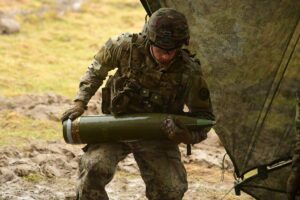Northrop Grumman Faces Financial Challenges Amidst B-21 Production Adjustments
Northrop Grumman recently reported a significant financial hit, amounting to a $477 million loss concerning the B-21 Raider project in the first quarter of 2025. This setback is largely attributed to the increased costs of manufacturing and materials for the cutting-edge stealth bomber.
The company revealed in a statement that the majority of this financial loss resulted from modifications to its B-21 production approach. These changes were aimed at enhancing the production rate, which inadvertently led to higher expenses.
During an earnings call with investors, Northrop CEO Kathy Warden highlighted that macroeconomic conditions are inflating the projected costs of bomber materials. The reported loss encompasses all five low-rate initial production (LRIP) lots for the bomber.
“While I’m disappointed with this financial impact, we continue to make solid progress on the [B-21] program, demonstrating performance objectives through tests, and we are progressing through the first two lots of production,” stated Warden. “With significant learning behind us, we are ready to deliver [to] the Air Force this highly capable strategic deterrent.”
This B-21-related loss contributed to an overall $183 million deficit in Northrop Grumman’s aeronautics systems division. Despite recording $2.8 billion in sales, the division experienced an 8% decline compared to the first quarter of 2024.
Overall profits for Northrop dropped by $498 million compared to the same period in 2024, marking a 46% reduction in operating income. This decline is predominantly due to the B-21 loss.
Kathy Warden elaborated that the B-21 is currently in the engineering and manufacturing development phase, undergoing crucial tests to ensure its operational capabilities. The company is advancing through the initial LRIP lots and has started preparatory work for subsequent lots.
“We’ve built a good bit of experience now in building the aircraft,” Warden noted, emphasizing that this experience helps mitigate risks associated with producing the new aircraft.
The B-21, set to replace older bombers like the B-1 Lancer and B-2 Spirit, was first unveiled in December 2022, with its maiden flight taking place in November 2023.
While development and testing have proceeded relatively smoothly, and the program has received commendations from officials and lawmakers, Warden cautioned investors about initial financial losses early in 2023, projecting future profitability.
The recent losses follow a previous $1.6 billion setback reported in late 2023. Former Air Force Secretary Frank Kendall informed lawmakers in April 2024 that the Air Force’s expenses for the bomber were decreasing due to negotiations with Northrop (source).
At the time of its rollout, the B-21’s inflation-adjusted average procurement unit cost was approximately $692 million. The Air Force plans to acquire at least 100 units, with the potential for additional purchases.
The manufacturing changes that contributed to this year’s losses stem from insights gained as Northrop scaled up production, according to Warden, and were made collaboratively with the Air Force. These insights will be fully integrated as Northrop transitions from the LRIP phase to full-scale production.
Warden acknowledged that the process changes played a more significant role in the B-21 loss than material costs.
In addition to the B-21, Northrop Grumman is developing the LGM-35A Sentinel intercontinental ballistic missile for the Air Force, intended to replace the aging Minuteman III missiles.
Warden reported that a successful static fire test of Sentinel’s first-stage solid rocket motor was conducted in March, in collaboration with the Air Force.
However, Sentinel faces substantial projected cost overruns due to unexpectedly high expenses in facility construction, such as launch centers. Northrop is actively working with the Air Force to reduce costs and enhance scheduling efficiency, Warden remarked.
“What we look at in [Sentinel’s program] restructuring is to ensure that the changes and requirements are adequately reflected in the design and ultimately in the contract, and we’ll be working to do that with the government,” Warden said.






